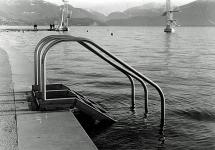|
Aka Arette A |
Manufactured or assembled in Germany from 1959 to (After) 1959.
Index of rarity in France: Infrequent (among non-specialized garage sales)
Inventory number: 12315
See the complete technical specifications
Chronology of cameras Aka
Although Aka had a short existence, the company produced a large number of camera models that shared a common quality of construction. The first series was called Akarette, which was soon followed by the Akarelle series. A few years later, a complete redesign of the cameras led to the creation of the Arette series.
The nomenclature of this series is somewhat complicated, as the models underwent significant changes, but sometimes retained the same names.
The first two models, introduced in 1956, were the Arette IA and l'Arette IB, which can be easily distinguished by the presence of a film advance lever on the top cover. Starting in 1957, the lever was moved to the bottom of the camera. Despite the changes, the names Arette IA and IB were retained. The Arette IC and ID were added to the range.
In 1958, the Arette IB was modified, and its top cover was redesigned to match those of the IC and ID. The name was changed to Arette BN, and the Arette C, Arette IDN/DN, and Arette BW were introduced.
In 1959, the models were once again modified to accommodate a large, bright viewfinder, which required raising the height of the top cover. A prototype with interchangeable lens, coupled rangefinder, exposure meter, and parallax-corrected viewfinder was presented at the 1958 Photokina and in some magazines. It was to be called the Arette Automatic S but never made it past the prototype stage. Instead, a much simpler camera bearing the same name was produced. It was accompanied by the Arette Automatic SE, which had a coupled rangefinder. The models with raised top covers are the Arette A, BN, Automatic S, Automatic SE, BW, and W.
Later on, the Arette A was renamed Arette Favorit, Arette P, and Arette Super P, depending on the shutter and lens.
In the early 1960s, if nothing changed technically, the Arettes were renamed Akarelle. The front aesthetics were revised (not necessarily for the better), and some models no longer seemed to be in-house productions.
__________
The top of the Arette A is too high to be elegant. The protrusion is necessary to accommodate the new large viewfinder. This viewfinder is the only quality that can be found in this basic model.


The history of the Aka brand (an acronym for Apparate & Kamerabau) is closely linked to World War II and its aftermath. The brand was founded in 1946 by the Armbuster brothers in the French sector. One of the brothers had skills in camera production, having worked for major German manufacturers of cameras and shutters. The other had a foundry and a tool factory.
Production of a central shutter camera with interchangeable lenses began in an old hotel in Wildbad. This camera was called the Akarette and aimed to be a more affordable competitor to the Leica. The first models produced negatives of 24 x 32 mm, which allowed for more shots per film. However, this was quickly abandoned in favor of the 24 x 36 mm standard. Production gradually increased with the German economy's recovery, requiring larger premises. Unable to find any in Wildbad, the company moved to the shores of Lake Constance, to Friedrichshafen, in the former pilot school. Production started there in April 1949. The range diversified with simpler models than the first Akarette, or more elaborate models with rangefinders.
In 1958, one of the brothers left the company for Feinwerktechnik, while developing a stereo camera compatible with View-Master, whose financing was a source of dispute between the brothers. This departure marked the beginning of the company's decline. Bankruptcy followed in 1960. A new company, Arette Feinwerktechnik GmbH, built cameras until 1963, using the parts still in stock.
Aka cameras are sometimes found at French flea markets. Sellers who know the history of their camera often mention its purchase by a conscript who served in Germany, either in the Black Forest or around Lindau, in the 1950s.
1 As a reminder, the French, American, British, and Soviet sectors were the result of the Yalta agreements that defined a partition of Nazi Germany between the victorious powers. Each occupying force exercised full administration over its sector. In 1949, the creation of the two German states significantly reduced the prerogatives of the four occupying nations. Military presence was maintained until after reunification in 1993.
2 Friedrichshafen is the city of Zeppelin and Dornier airplanes.
(original document in german)
Interesting links or bibliography :
Add a link or element of bibliography, a picture taken with this camera, a picture of box or an ads about this camera
Your photos taken with the same camera:
Cameras from Ebay France (Aka) (Uploaded each 3 hours)








